February 24 - March 2, 2013: Issue 99
Dollarbird and Oystercatcher Familes
Pittwater is currently flush with families of birds which return here each Summer to breed young and feed them before returning to wintering grounds. Most of these, although thriving because of our creeks, coastal rock platforms and wetlands, are creatures that extensively belong to the salt air. These two Dollarbirds, a parent and young, were spotted at Careel Bay where the fledgling was heard calling for more food quite distinctly. Most birdwatchers know you often hear a bird prior to being able to see it and the insistent call of the young one pictured here was heard and led to seeing them. They are still there at present if you wish to have a look for yourself.
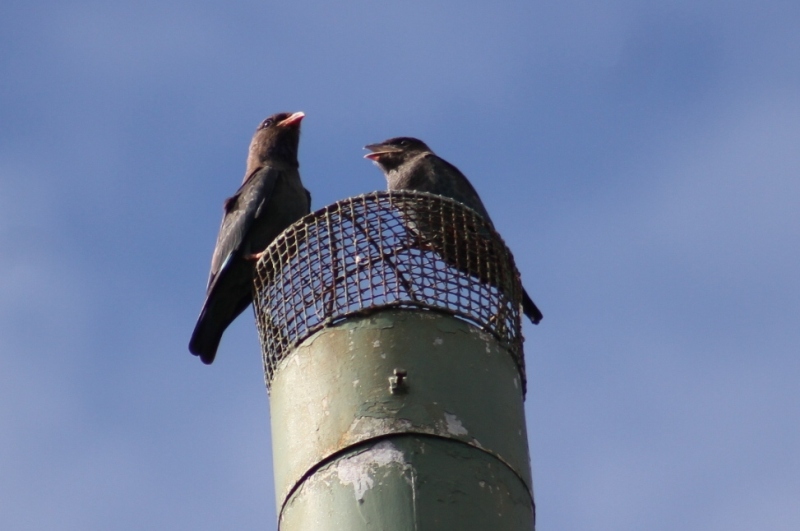
Dollarbirds
The origin of the Dollardbird's name stems from the silvery, circular patches on the underside of the wings, thought to resemble the American silver dollar coin. The Dollarbird, Eurystomus orientalis, is the sole Australian representative of the Roller family, so named because of their rolling courtship display flight. The Dollarbird visits Australia each year to breed. It has mostly dark brown upperparts, washed heavily with blue-green on the back and wing coverts. The breast is brown, while the belly and undertail coverts are light, and the throat and undertail glossed with bright blue. The flight feathers of the wing and tail are dark blue. The short, thick-set bill is orange-red, tipped with black. In flight, the pale blue coin-shaped patches towards the tips of its wings, that gave the bird its name, are clearly visible. Both sexes are similar, although the female is slightly duller. Young Dollarbirds are duller than the adults and lack the bright blue gloss on the throat. The bill and feet are brownish in colour instead of red. The distinctive, harsh 'kak-kak-kak' call is repeated several times, and is often given in flight.
The Dollarbird arrives in northern and eastern Australia in September each year to breed. In March or April the birds return to New Guinea and adjacent islands to spend their winter. When in Australia they will inhabit open wooded areas, normally with mature, hollow-bearing trees suitable for nesting or alongside our creeks and waterways where their food, mainly flying insects, is also in abundance at this time of year. During their breeding season pairs of Dollarbirds are often seen flying in characteristic rolling flights. These flights are more common in the evening, and are accompanied by cackling calls. The white eggs are laid in an unlined tree hollow and are incubated by both adults. The young birds are also cared for by both parents. The same nesting site may be used for several years.
The Anula tribe of Northern Australia associate the dollar-bird with rain, and call it the rain-bird. A man who has the bird for his totem can make rain at a certain pool. He catches a snake, puts it alive into the pool, and after holding it under water for a time takes it out, kills it, and lays it down by the side of the creek. Then he makes an arched bundle of grass stalks in imitation of a rainbow, and sets it up over the snake. After that all he does is to sing over the snake and the mimic rainbow; sooner or later the rain will fall. They explain this procedure by saying that long ago the dollar-bird had as a mate at this spot a snake, who lived in the pool and used to make rain by spitting up into the sky till a rainbow and clouds appeared and rain fell. From Sir James George Frazer (1854–1941). The Golden Bough. 1922. Ch. 2. The Magical Control of Rain.
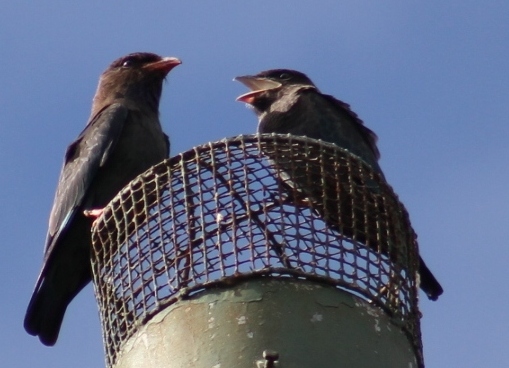
Sooty Oystercatchers
At Narrabeen Rock platform, and intertidal rock shelf that juts out into the sea and part of our Marine Reserves, three Oystercatchers were recently spotted. Liz Kelly, a swim instructor at the Rockpool for over 25 years now, has seen a family of oystercatchers return here every Summer for many years now.
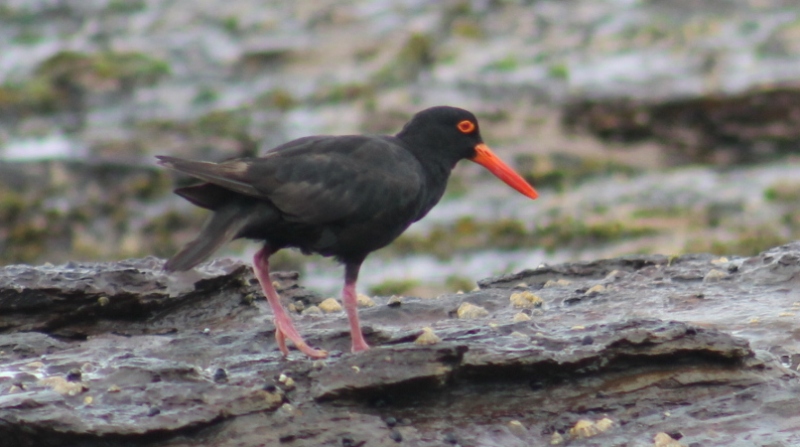
These are Sooty Oystercatchers, Haematopus fuliginosus, a Seabird classified among Australia’s Shore birds and waders species, and are a black shorebird with a long red bill, red eye and pink legs. Young birds are duller and browner. It is often seen with the similar Pied Oystercatcher and they are Australia’s only all-black seabird and is found only found in coastal areas. The Sooty Oystercatcher is strictly coastal, usually within 50 m of the ocean. It prefers rocky shores, but will be seen on coral reefs or sandy beaches near mudflats. It breeds on offshore islands and isolated rocky headlands.
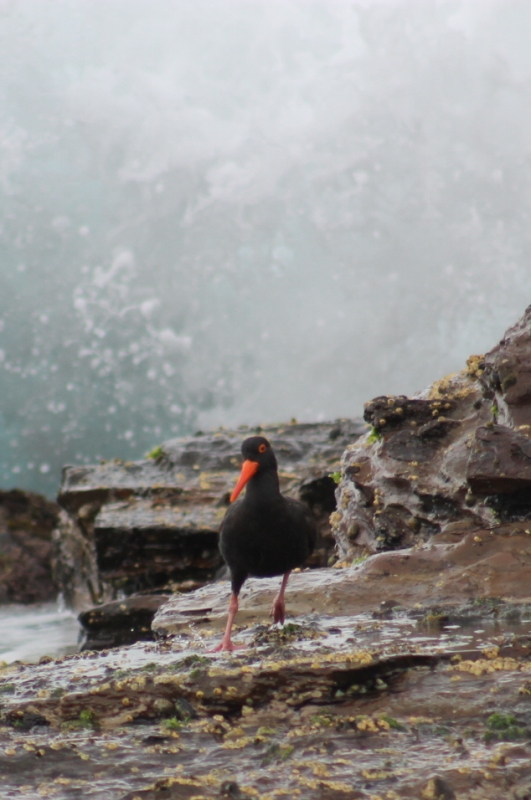 They are mostly resident and territorial, moving to islands to breed. The oystercatchers are a group of waders; they form the family Haematopodidae, which has a single genus, Haematopus. They are found on coasts worldwide apart from the polar regions and some tropical regions of Africa and South East Asia. The exception to this is the Eurasian Oystercatcher and the South Island Oystercatcher, both of which breed inland. In the past there has been a great deal of confusion as to the species limits, with discrete populations of all black oystercatchers being afforded specific status but pied oystercatchers being considered one single species.
They are mostly resident and territorial, moving to islands to breed. The oystercatchers are a group of waders; they form the family Haematopodidae, which has a single genus, Haematopus. They are found on coasts worldwide apart from the polar regions and some tropical regions of Africa and South East Asia. The exception to this is the Eurasian Oystercatcher and the South Island Oystercatcher, both of which breed inland. In the past there has been a great deal of confusion as to the species limits, with discrete populations of all black oystercatchers being afforded specific status but pied oystercatchers being considered one single species.
The name oystercatcher was coined by Mark Catesby in 1731 as a common name for the North American species H. palliatus, described as eating oysters. Yarrell in 1843 established this as the preferred term, replacing the older name Sea Pie. John Gould described the Sooty Oystercatcher in 1845. Its species name is the Latin adjective fuliginosus, "sooty". Two subspecies are recognised, the nominate from the coastline of southern Australia and subspecies ophthalmicus from northern Australia. The southern subspecies is larger and heavier than the northern. The northern one, with a more yellowish eye ring, is found from the Kimberleys across the top of the country to Mackay in central Queensland. There is considerable overlap, as the southern subspecies has been found up to Cape York. Subspecies ophthalmicus has been thought distinctive enough to warrant species status and needs further investigation. Black redbill is a local name.
The heaviest of all oystercatchers, the Sooty Oystercatcher weighs up to 980 g (2.2 lb), averaging around 819 g (1.81 lb), with females larger and heavier in both subspecies. Males have shorter, thicker bills and females have longer, thinner bills. The 19% average difference in length is the most marked of any oystercatcher species. Immature birds, which one of the three seen at Narrabeen was, have grey-brown legs, a bill tipped with brown, a browner cast to their plumage and brown eyes. The bill, eyes and legs become red by the second year.
Preferring rocky shores, the Sooty Oystercatcher is endemic to Australia. There are an estimated 11,500 individuals, 4000 of the nominate race and 7500 of the northern race. It is common around the Tasmanian coastline and Bass Strait islands. They are it is declared Rare in South Australia and Queensland, Near Threatened in Victoria and Endangered in New South Wales (1).
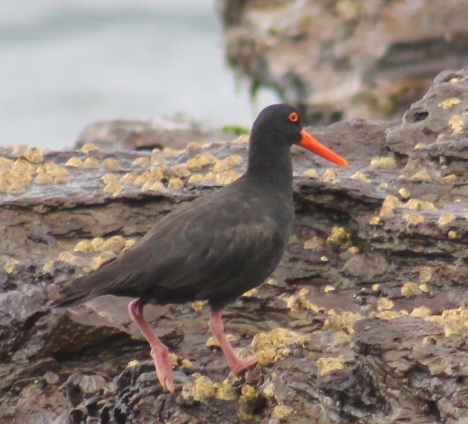 True to its name the Sooty Oystercatchers feeds on molluscs, crabs and other crustaceans, marine worms, starfish and sea urchins, and small fish. It uses its long bill to stab at prey or to lever, prise or hammer open food items. It drinks seawater. The Sooty Oystercatcher almost always forages in the intertidal zone, for the two hours either side of low tide. A field study published in 2011 showed that prey items differed markedly between the sexes with only a 36% overlap. Females focussed on soft-bodied prey which they could swallow whole such as fish, crabs, bluebottle jellyfish and various worm-like creatures such as cunjevoi, while males preferred hard-shelled prey such as mussels (Mytilus planulatus), sea urchins, turban shells (Turbo undulatus and Turbo torquata), and black periwinkle (Nerita atramentosa). (2.)
True to its name the Sooty Oystercatchers feeds on molluscs, crabs and other crustaceans, marine worms, starfish and sea urchins, and small fish. It uses its long bill to stab at prey or to lever, prise or hammer open food items. It drinks seawater. The Sooty Oystercatcher almost always forages in the intertidal zone, for the two hours either side of low tide. A field study published in 2011 showed that prey items differed markedly between the sexes with only a 36% overlap. Females focussed on soft-bodied prey which they could swallow whole such as fish, crabs, bluebottle jellyfish and various worm-like creatures such as cunjevoi, while males preferred hard-shelled prey such as mussels (Mytilus planulatus), sea urchins, turban shells (Turbo undulatus and Turbo torquata), and black periwinkle (Nerita atramentosa). (2.)
OYSTER-CATCHER Among the Gaels this bird is an emblem of St. Bride, who carried one in each hand. In Scotland it bears the form of a cross on its plumage as it once covered Christ with sea-weed when his enemies pursued him. # 454: It is called Brid-eun, 'Bride's Bird' or Bigein-Bride, 'Bride's Boy', in Gaelic. # 161 - 225 – 454 (5.)
Finally a ‘wee’ snippet of an oystercatcher in myths from Wonder Tales from Scottish Myth and Legend, Chapter II, The coming Of Angus and Bride: retrieved from: http://www.sacred-texts.com/neu/celt/tsm/tsm05.htm
Angus first beheld Bride in a dream, and when he awoke he spoke to the King of the Green Isle, saying: "Last night I dreamed a dream and saw a beautiful princess whom I love. Tears fell from her eyes, and I spoke to an old man who stood near her, and said: 'Why does the maiden weep?' Said the old man: 'She weeps because she is kept captive by Beira, who treats her with great cruelty.' I looked again at the princess and said: 'Fain would I set her free.' Then I awoke. Tell me, O king, who is this princess, and where shall I find her?"
The King of the Green Isle answered Angus, saying: "The fair princess whom you saw is Bride, and in the days when you will be King of Summer she will be your queen. Of this your mother, Queen Beira, has full knowledge, and it is her wish to keep you away from Bride, so that her own reign may be prolonged. Tarry here, O Angus, until the flowers been to bloom and the grass begins to grow, and then you shall set free the beautiful Princess Bride."
Said Angus: "Fain would I go forth at once to search for her."
"The wolf-month (February) has now come," the king said. "Uncertain is the temper of the wolf."
Said Angus: "I shall cast a spell on the sea and a spell on the land, and borrow for February three days from August."
He did as he said he would do. He borrowed three days from August, and the ocean slumbered peacefully while the sun shone brightly over mountain and glen. Then Angus mounted his white steed and rode eastward to Scotland over the isles and over the Minch, and he reached the Grampians when dawn was breaking. He was clad in raiment of shining gold, and from his shoulders hung his royal robe of crimson which the wind uplifted and spread out in gleaming splendour athwart the sky.
An aged bard looked eastward, and when he beheld the fair Angus he lifted up his harp and sang a song of welcome, and the birds of the forest sang with him. And this is how he sang:
Angus hath come--the young, the fair,
The blue-eyed god with golden hair--
The god who to the world doth bring
This morn the promise of the spring;
Who moves the birds to song ere yet
He bath awaked the violet,
Or the soft primrose on the steep,
While buds are laid in lidded sleep,
And white snows wrap the hills serene,
Ere glows the larch's vivid green
Through the brown woods and bare. All hail!
Angus, and may thy will prevail. . . .
He comes . . . he goes. . . . And far and wide
He searches for the Princess Bride.
Up and down the land went Angus, but he could not find Bride anywhere. The fair princess beheld him in a dream, however, and knew that he longed to set her free. When she awoke she shed tears of joy, and on the place where her tears fell there sprang up violets, and they were blue as her beautiful eyes.
Beira was angry when she came to know that Angus was searching for Bride, and on the third evening of his visit she raised a great tempest which drove him back to Green Isle. But he returned again and again, and at length he discovered the castle in which the princess was kept a prisoner.
Then came a day when Angus met Bride in a forest near the castle. The violets were blooming and soft yellow primroses opened their eyes of wonder to gaze on the prince and the princess. When they spoke one to another the birds raised their sweet voices in song and the sun shone fair and bright.
Said Angus: "Beautiful princess, I beheld you in a dream weeping tears of sorrow."
Bride said: "Mighty prince, I beheld you in a dream riding over bens and through glens in beauty and power."
Said Angus: "I have come to rescue you from Queen Beira, who has kept you all winter long in captivity."
Bride said: "To me this is a day of great joy."
Said Angus: "It will be a day of great joy to all mankind ever after this."
That is why the first day of spring-the day on which Angus found the princess-is called "Bride's Day".
Through the forest came a fair company of fairy ladies, who hailed Bride as queen and bade welcome to Angus. Then the Fairy Queen waved her wand, and Bride was transformed. As swiftly as the bright sun springs out from behind a dark cloud, shedding beauty all round, so swiftly did Bride appear in new splendour. Instead of ragged clothing, she then wore a white robe adorned with spangles of shining silver. Over her heart gleamed a star-like crystal, pure as her thoughts and bright as the joy that Angus brought her. This gem is called "the guiding star of Bride ". Her golden-brown hair, which hung down to her waist in gleaming curls, was decked with fair spring flowers--snowdrops and daisies and primroses and violets. Blue were her eyes, and her face had the redness and whiteness of the wild rose of peerless beauty and tender grace. In her right hand she carried a white wand entwined with golden corn-stalks, and in her left a golden horn which is called the "Horn of Plenty".
The linnet was the first forest bird that hailed Bride in her beauty, and the Fairy Queen said:
"Ever after this you shall be called the 'Bird of Bride'."
On the seashore the first bird that chirped with joy was the oyster-catcher, and the Fairy Queen said: "Ever after this you shall be called the 'Page of Bride'."
References:
1. NSW Scientific Committee (May 2008). "Sooty OystercatcherHaematopus fuliginosus: Review of Current Information in NSW". Hurstville, NSW. Retrieved 16 September 2012.
2. Aplin, Lucy Margaret; Cockburn, Andrew (2012). "Ecological Selection and Sexual Dimorphism in the Sooty Oystercatcher, Haematopus fuliginosus". Austral Ecology 37(2): 248–57. doi:10.1111/j.1442-9993.2011.02263.x
3. Sooty Oystercatcher. (2012, December 20). In Wikipedia, The Free Encyclopedia. Retrieved from http://en.wikipedia.org/w/index.php?title=Sooty_Oystercatcher&oldid=529022870
4. Eurystomus solomonensis = Eurystomus orientalis solomonensis Oriental Dollarbird ssp. (in front); and Eurystomus azureus Purple Dollarbird (behind)
Date 1892, Source Catalogue of the birds in the British Museum. Volume 17, by Johannes Gerardus Keulemans (J. G. Keulemans) (8 June 1842 – 29 March 1912) a Dutch bird illustrator.
5. From Encyclopaedia of the Celts : http://www.summerlands.com/crossroads/library/ENCYCLOPEDIA%20OF%20THE%20CELTS/Encyclopedia%20of%20the%20Celts%20%20O%20-%20Oyster-Catcher.htm
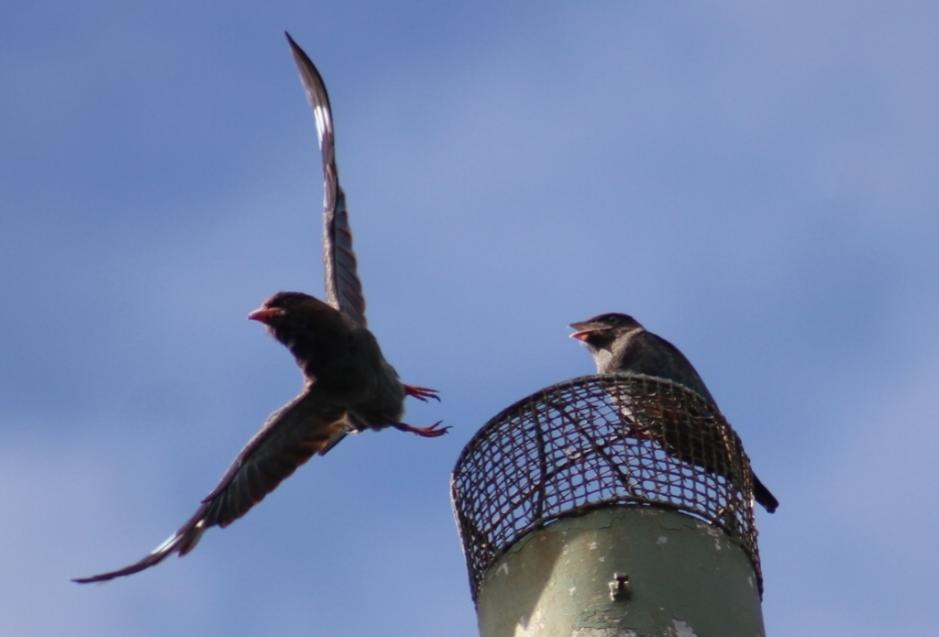

Report and Photos by A J Guesdon, 2013. All Rights Reserved.